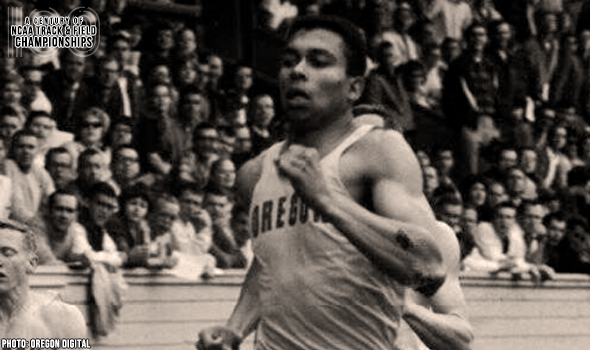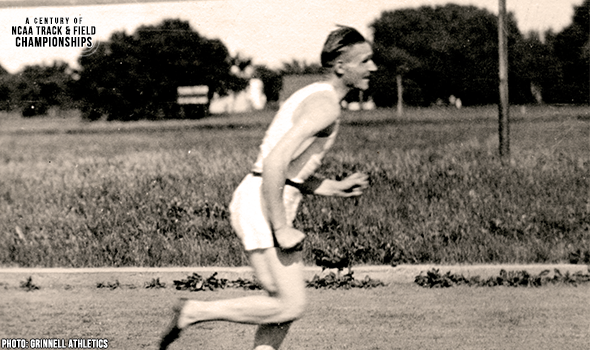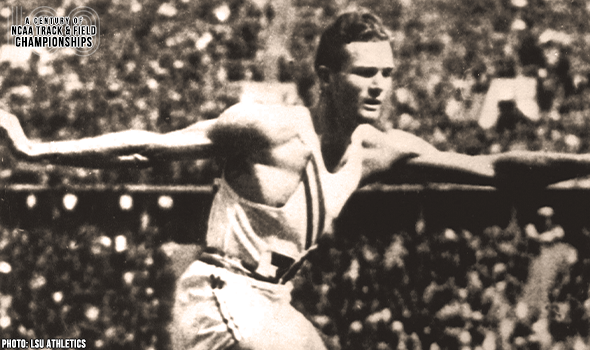
Oregon’s Jerome Sprinted To NCAA Glory
If ever a meet could have used photo-finish timing, it was the 1964 NCAA Outdoor Track & Field Championships.
The 5000 and 400 were both ruled deadlocks, but those were with merely two runners inseparable.
The 100-meter final saw three sprinters crossing the line at almost the same instant: Harry Jerome of Oregon, Edwin Roberts of North Carolina Central and Trenton Jackson of Illinois.
It took almost an hour to sort the finish, but when they did, Jerome was ruled the victor in 10.1. Roberts (second) and Jackson (third) were also credited with that same mark as well.
“Honestly, that’s one I’d hate to judge on,” Jerome said about the finish to Dick Leutzinger of the Eugene Register-Guard. “Usually I know when I win or lose. I’d hate to say on that one.”
While the 10.1 was a meet and collegiate record, it wasn’t a PR for Jerome. He still owned a share of the world record of 10.0 that he set in the summer after his freshman season back in 1960.
Jerome was a Canadian prodigy who came from great lineage. As a high school standout in North Vancouver, British Columbia, he broke a 31-year-old national record in the 220 yards. And many knew his grandfather, John Armstrong Howard, who was the first Black athlete to represent Canada in the Olympic Games.
The fact that Jerome was even running in 1964 – near his best, let alone at all – was a comeback story for the ages. Jerome tore his quadriceps tendon in the fall of 1962 at the British Commonwealth Games and the seriousness of the injury led many to believe that he would never run again. He didn’t believe that and a little over a year later, he opened the 1964 season by equaling the world indoor best in the 60-yard dash with his time of 6.0.
Then at the 1964 NCAA Championships, Jerome doubled back in the 200, taking third to lead Oregon to its second team title in three years – both at Hayward Field. The Ducks won their first national title in 1962 when Jerome won the 220 yards and was runner-up in the 100.
Not long after that, Jerome went to the Tokyo Olympic Games, where he earned his lone Olympic medal – a bronze in the 100.
Jerome died in 1982 of a brain aneurysm at age 42. In 1984, the Labatts Classic held in Burnaby was renamed the Harry Jerome Classic and in 1988 a statue of him was erected in Vancouver’s Stanley Park.
The NCAA and collegiate track & field will mark a momentous milestone in the spring of 2021 -- the 100th anniversary of the NCAA Championships and with that, the NCAA Track & Field Championships. In June 1921, the University of Chicago hosted the first track & field championships in NCAA history.
This point can’t be emphasized enough: Not only was the event the first for NCAA track & field, but the first championships for any sport under the sponsorship of the NCAA.
To celebrate, over each of the next 365 days, the U.S. Track & Field and Cross Country Coaches Association (USTFCCCA) will celebrate moments, student-athletes, and coaches that have made a century’s worth of championships special. From humble beginnings to important historical milestones to the modern-day, collegiate track & field has evolved with the American society.
The 2021 edition of the NCAA Division I Outdoor Track & Field Championships begin with preliminary round action on May 27-29 in Jacksonville, Fla., and College Station, Texas. The championships final site and culmination of the celebration is slated for June 9-12, 2021 at the newly rebuilt Hayward Field in Eugene, Ore.

SIU’s Roggy Dominated The Javelin In 1978
Bob Roggy won the javelin title at the 1978 NCAA DI Outdoor T&F Championships by more than 20 feet. Roggy qualified first for the final with a MR heave of 89.30m (293‑0).

Makusha Made History In Bowerman Year Of 2011
Ngoni Makusha became just the fourth man in meet history to win individual titles in both the 100 and LJ. It was his 3rd career LJ crown and he set a CR in the 100 of 9.89.

George Mason’s Gage Shocked The NCAA LJ In 1988
Nena Gage won the long jump at the 1988 NCAA DI Outdoor T&F Championships in a shocking upset over Gail Devers.

Texas’ Thompson Marveled In NCAA Distance Events
Jerry Thompson won three career distance titles at the NCAA Outdoor T&F Championships. His first came in 1943. Then he won again in 1947 & 1948 after serving in World War II.

Grinnell’s Paulu Sprinted To NCAA History
Leonard Paulu was the first athlete to complete the 100-200 double in NCAA Outdoor Track & Field Championships history in 1922. That also made him the 1st to win back-to-back 100 titles, too.

Scott Won Back-To-Back NCAA Hammer Titles
Candice Scott won back-to-back hammer throw titles at the NCAA DI Outdoor T&F Championships in 2003 & 2004. Scott set a meet record of 69.77m (228-11) in that first year.

Drouin Soared To The Bowerman In 2013
Derek Drouin won two career HJ titles at the NCAA DI Outdoor T&F Championships. When Drouin won in 2013, he was only the fourth man to clear 2.34m (7-8) in meet history.

Watts Made Quick Work Of NCAA 400
Quincy Watts set a meet record in the 400 of 44.00 at the 1992 NCAA DI Outdoor Track & Field Championships. It lasted 25 years until 2017.

Iowa State’s Koll Rolled To 5K-10K Crowns
Lisa Koll won three career titles at the NCAA DI Outdoor T&F Championships in dominant fashion. Her average margin of victory in those 5K & 10K races was 37.73 seconds.

LSU’s Hardin Completed Unique 440-220H Double Twice
The nearly unheard of 440-220H double was so nice that Glenn Hardin did it twice! Hardin became the first to do so in meet history in 1933 and then swept them again in 1934.

